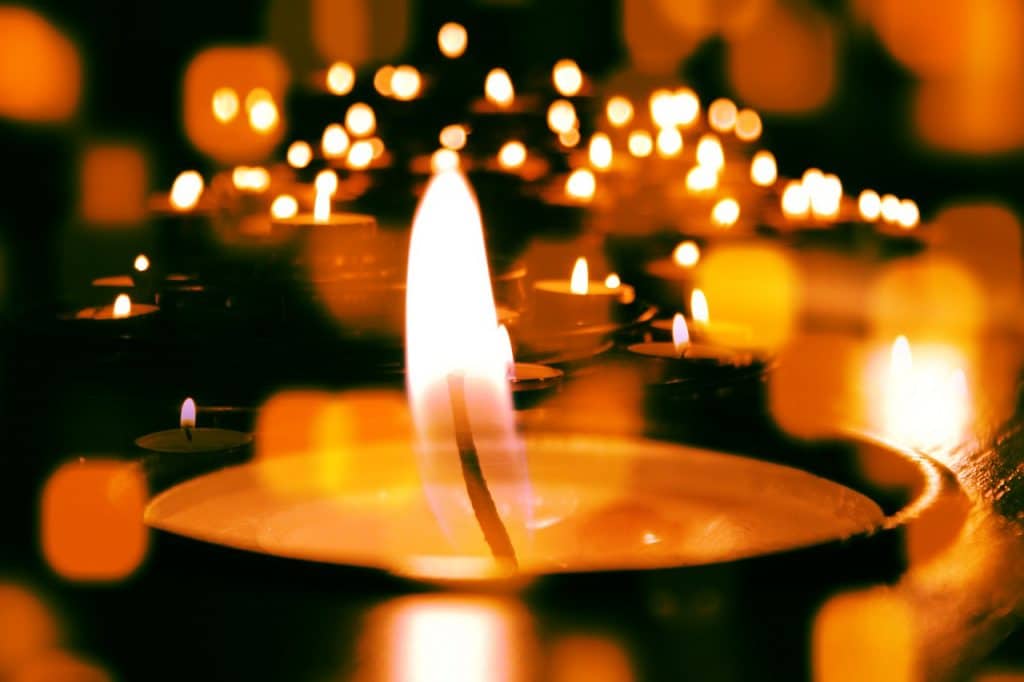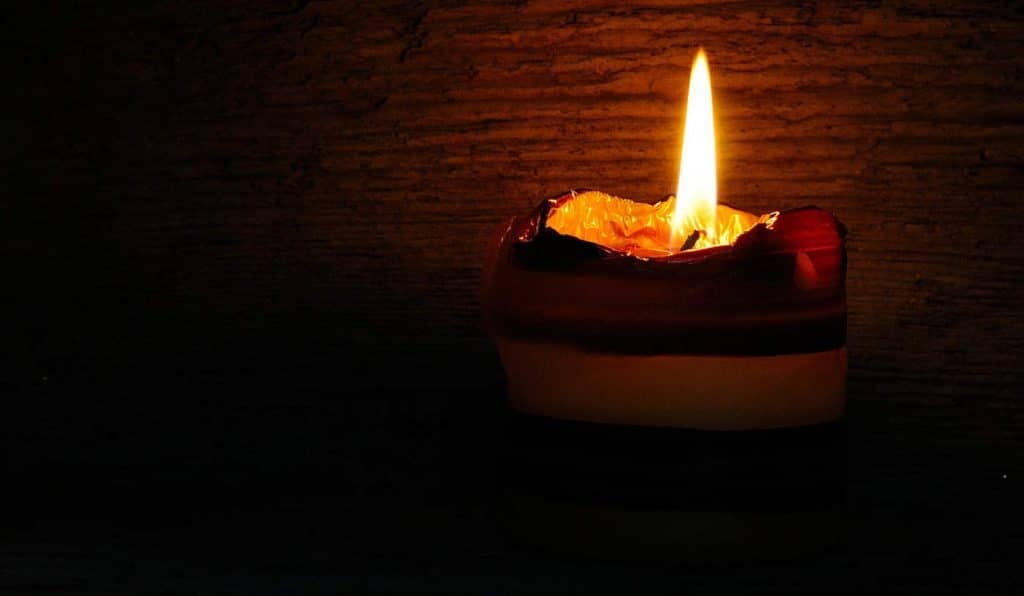Coming home after a tiring day, we’d all love to unwind in the refreshingly scented atmosphere. Scented candles serve the purpose very well! They are perfect for lifting your moods and make you feel calm and relaxed.
Scented candles are popular among the masses for creating ambience at home or used as decoration at the in-house dinner party. Their sales are soaring with candles bought as gifts. Did you know that these seemingly harmless candles could be filling your house with carcinogenic soot and lead?
Hearing this, you might clutch your candles to your chest before someone pry them out of your soot-stained hands. Relax! Those concerned about the islands flooding due to ice melting can use a simple alternative to make their candles eco-friendly.

Are candles really bad for your house?
Many articles on the internet claim that burning candles are bad for our house and health. This is because most candles are made from paraffin wax, a petroleum by-product. The U.S. Food and Drug Administration has approved the use of food-grade paraffin in food, candles, cosmetics, and other applications.
However, it is said to release carcinogenic chemicals such as volatile organic compounds (VOCs), including acetone, benzene, and toluene, in soot when burned. It is also reported that the emissions are much greater from scented candles than their counterparts. Breathing in these chemicals, though minimal in concentrations, can be potentially harmful to our health. They can cause or aggravate respiratory and heart problems.
Not only wax, lead-loaded wicks, and synthetic fragrances also play their part. Candles with lead-core wick are five times harmful to children in your house. Lead exposure has been associated with hormone disruption, behavioral problems, and learning disabilities, etc.
Scented candles that might give you vibes of a healthy drink of fresh-squeezed juice with a shot of gasoline and synthetic oils release microscopic particles. These particles cause cancer and other medical problems when inhaled.
However, people on the other side of the table argue that toxic chemicals and lead concentrations are well below limits to be a health threat. As per some medical experts, there’s no hard evidence that everyday use of candles poses any risk to the lungs or develops cancer. However, if it is burning and inhaling candles in an unventilated space every day for years may cause a problem. Furthermore, burning an unattended candle for too long might also cause property damage to your house.
But, those days are long gone when it was100% paraffin. Modern candles are made of plant or animal-derived wax that is safe to use. Manufacturers have blended different raw materials to produce the best candles, including a bit of paraffin for a brighter flame, clean burn, and good fragrance throw. Furthermore, the use of lead-core wick was banned in 2003. So, you don’t have to worry about wick today unless you have inherited some decades-old candles.
Do modern candles have lead-core wicks?
Lead core candle wicks have been the topic of debate for so long. Burning a lead-core wick poses a risk of lead poisoning for young children. It releases five times more lead than the safe permissible limit for children, far greater than environmental pollution standards permit.
Today, most candles are manufactured and sold with lead-free wicks after the U.S. Consumer Product Safety Commission (CPSC) banned lead in 2003. Some, however, still contain lead; others have zinc or tin. The import of lead-containing candles from other countries is also banned. Lead can cause hormonal and behavioral disruptions.
Having said that, if you’re unsure about your wick, you can do a test. Simply peel off the cotton (wrapped around metal support) and see if there’s metal or lead inside. If so, don’t burn the candle. Also, you can turn the candle upside down and rub the tip of the wick on paper. If it leaves behind a grey mark as a pencil would, its wick contains lead. This is particularly helpful for scented candles because the fragrance oils soften the wax and melt the non-cored wicks. If you haven’t burned the candle yet, take it back to the store and ask for a refund.
Do candles release toxic chemicals, particulate matter, and volatile organic compounds in your house?
The burning of candles is a combustion process that releases carbon dioxide and soot into the air. The soot contains volatile organic compounds and particulate matter. It is said that prolonged exposure to particulate matter can lead to serious health problems.
For your insight, particulate matter (PM) refers to solid and liquid particles suspended in the air we breathe. They can go past our body’s defense barrier and infiltrate deep into our lungs, where they can cause coughing, respiratory irritation, or asthma, and acute health issues like heart stroke. And VOCs, like formaldehyde and benzene, are potentially carcinogenic. We’re exposed to these toxic chemicals in our daily lives. The sources include anything and everything that burns fossil fuels, such as car exhaust, factory outlets, etc.
The European Candle Association funded a study in 2007 that examined every major type of wax for 300 toxic chemicals. The researchers found that the toxic chemicals were released well below the amount that would pose a risk to human health.
Later, a 2009 study tested candles made from every type of wax and reported that burning a candle made with paraffin wax, a petroleum by-product, releases over 300 potentially harmful chemicals that can cause respiratory irritation at elevated levels.
However, the study was never approved by the National Candle Association and European Candle Association. According to the statement released by European Candle Association, no data was provided for the review. The study was never published in a peer-reviewed journal; none other scientific research has ever shown any candle wax, including paraffin, to be harmful to human health.
A recent study aimed at estimating the amount of particulate matter released from burning candles concluded that burning scented candles under normal conditions does not pose known health risks.
So far, there’s no scientific indication that burning a candle is any worse than inhaling cigarettes or traffic smoke to which we’re exposed regularly. Occasional exposure to candle emissions wouldn’t affect you as much as a prolonged exposure in a poorly ventilated space. However, if you’re conscious about your health and well-being, you can opt for benign candles made from beeswax, soy wax, or other plant or animal-based waxes.
Are scented candles bad for your house?
Scented candles effectively create a pleasant, relaxing ambiance at home or office and for Aromatherapy. Scents such as jasmine, lavender, citrus, pine, cinnamon, and sandalwood can be relaxing and refreshing.
However, burning (any) scented candle releases small amounts of chemicals from its wax, wick, or fragrance oil. Most scented candles contain synthetic fragrance oils that release VOCs like formaldehyde even when unlit. Yet, it isn’t clear if this impacts your health negatively. Your favorite apple pie and pine tree scent don’t contain carcinogens, right, because all scents comply with the International Fragrance Association standards.
So far, the wax, wick, and fragrances have been declared harmless for human health and indoor air quality. It’s possible that you have an allergic reaction to scented candles. Symptoms may include nose irritation, sneezing, runny nose, sinus blockage, headaches, and dizziness, resulting from prolonged exposures in a closed environment.

Are plant-based or animal-based candles bad for your house?
There are many sustainable options available when it comes to candles. You can select from a wide range of plant or animal-based candles which produce less soot and toxic chemicals. The most popular of them include soy wax candles, palm wax candles, coconut wax candles, and beeswax candles. A small amount of paraffin wax is added to them to enhance their scent throw.
Should you leave your candle burning for long hours?
(from the article “How long will your candle burn?)
This depends on what kind of candle (paraffin, mineral oil, beeswax, etc.) you use, the ventilation of your room, and the number of flammable substances in the vicinity of your candle.
For traditional candles, i.e., fossil-origin paraffin candles, the wax contains volatile carcinogenic compounds. These harmful toxins are released into the air during candle combustion and inhaled by us. In the small, air-tight space, this can lead to congestion and asphyxiation.
Logically, anything that burns releases chemical-laden smoke in the air though minor in concentration and affects the air quality. However, these candles release half as much soot and toxic chemicals as conventional candles that are less likely to harm your health.
Hence these candles won’t fill your lungs or indoor air with poisonous fumes or stain your drapes and walls with black soot. Most of these candles also burn evenly for longer hours; thus, they’re totally worth their high prices.




